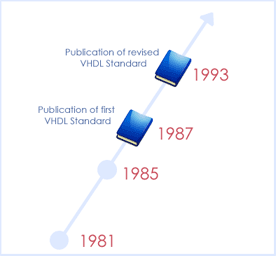The development of VHDL was initiated in 1981 by the United States Department of Defence to address the hardware life cycle crisis. The cost of reprocuring electronic hardware as technologies became obsolete was reaching crisis point, because the function of the parts was not adequately documented, and the various components making up a system were individually verified using a wide range of different and incompatible simulation languages and tools. The requirement was for a language with a wide range of descriptive capability that would work the same on any simulator and was independent of technology or design methodology.
The standardization process for VHDL was unique in that the participation and feedback from industry was sought at an early stage. A baseline language (version 7.2) was published 2 years before the standard so that tool development could begin in earnest in advance of the standard. All rights to the language definition were given away by the DoD to the IEEE in order to encourage industry acceptance and investment.
DoD Mil Std 454 mandates the supply of a comprehensive VHDL description with every ASIC delivered to the DoD. The best way to provide the required level of description is to use VHDL throughout the design process.
As an IEEE standard, VHDL must undergo a review process every 5 years (or sooner) to ensure its ongoing relevance to the industry. The first such revision was completed in September 1993, and this is still the most widely supported version of VHDL.
One of the features that was introduced in VHDL-1993 was shared variables. Unfortunately, it wasn't possible to use these in any meaningful way. A working group eventually resolved this by proposing the addition of protected types to VHDL. VHDL 2000 Edition is simply VHDL-1993 with protected types.
VHDL-2002 is a minor revision of VHDL 2000 Edition. There is one significant change, though: the rules on using buffer ports are relaxed, which makes these much more useful than hitherto.
In 2007, an amendment to VHDL 2002 was created. This introduces the VHDL Procedural Interface (VHPI) and also makes a few minor changes to the text of VHDL 2002. Apart from the VHPI itself, no new features were added to VHDL.
The VHPI allows tools programmable access to a VHDL model before and during simulation. In other words, you can write programs in a language such as C that interact with a VHDL simulator.
The next revision of VHDL was released in January 2009, and is referred to as "VHDL-2008". Further details can be found here.
| 1981 | Initiated by US DoD to address hardware life-cycle crisis |
| 1983-85 | Development of baseline language by Intermetrics, IBM and TI |
| 1986 | All rights transferred to IEEE |
| 1987 | Publication of IEEE Standard |
| 1987 | Mil Std 454 requires comprehensive VHDL descriptions to be delivered with ASICs |
| 1994 | Revised standard (named VHDL 1076-1993) |
| 2000 | Revised standard (named VHDL 1076-2000 Edition) |
| 2002 | Revised standard (named VHDL 1076-2002) |
| 2007 | VHDL Procedural Language Application Interface standard (VHDL 1076c-2007) |
| 2009 | Revised Standard (named VHDL 1076-2008) |

Your email comments are welcome - send email
Copyright 1995-2014 Doulos